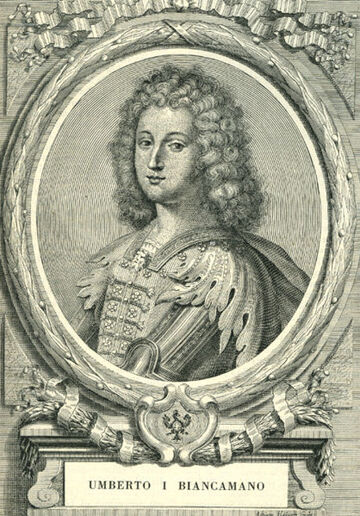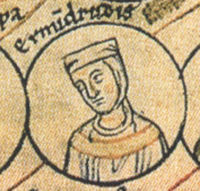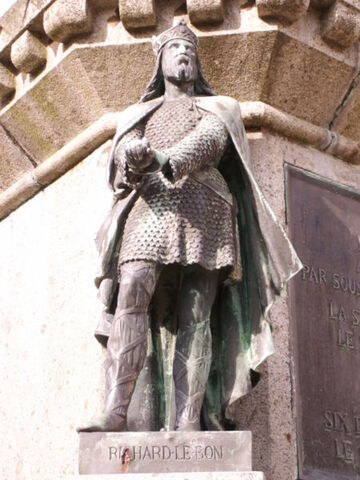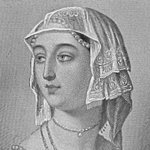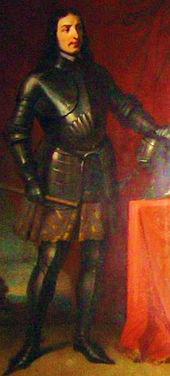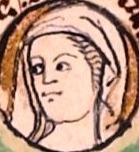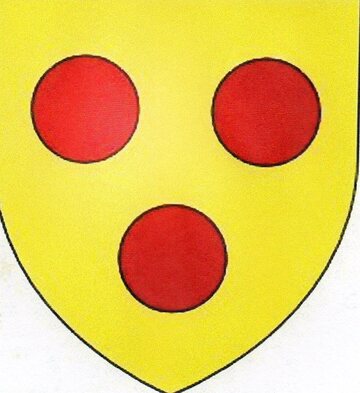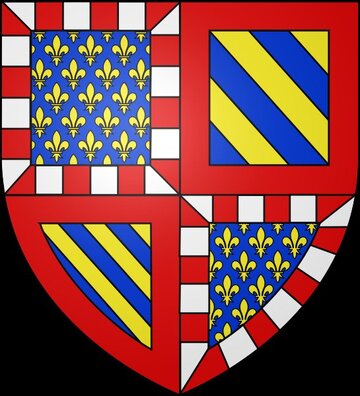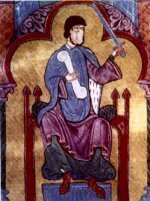maximum test » Guillaume I 'Le Grand' "Guillaume II comte de Bourgogne & Macon" de Bourgogne comte palatin de Bourgogne (1020-1087)
Persoonlijke gegevens Guillaume I 'Le Grand' "Guillaume II comte de Bourgogne & Macon" de Bourgogne comte palatin de Bourgogne
Bronnen 1, 2, 3, 4, 5- Roepnaam is Guillaume II comte de Bourgogne & Macon.
- Hij is geboren in het jaar 1020 in BourgogneFrance.
- Hij werd gedoopt in het jaar 1057 in Count of, BURGUNDY, France.
- Alternatief: Hij werd gedoopt in het jaar 1057 in Count of, BURGUNDY, France.
- Alternatief: Hij werd gedoopt in het jaar 1057 in Count of, BURGUNDY, France.
- Gedoopt (op 8-jarige leeftijd of later) door het priesterschapsgezag van de LDS-kerk op 26 augustus 1993.
- Titel: Conte
- Beroepen:
- Greve.
- unknown in Count of Burgundy.
- Comte, de Bourgogne, 1057/1087, Comte, de Mâcon, 1078/1085.
- Comte de bourgogne.
- Conde Paladino da Borgonha.
- Hij is overleden op 12 november 1087, hij was toen 67 jaar oudBesançon
Franche-Comté France. - Hij is begraven december 1087 in Cathedral de St-JeanBesançon
Franche-Comté France. - Een kind van Reginald I Ivrea en Adeliza de Normandie
- Deze gegevens zijn voor het laatst bijgewerkt op 5 februari 2020.
Gezin van Guillaume I 'Le Grand' "Guillaume II comte de Bourgogne & Macon" de Bourgogne comte palatin de Bourgogne
Hij is getrouwd met Stephanie countess consort of Bourgogne countess consort of Bourgogne.
Zij zijn getrouwd in het jaar 1049, hij was toen 29 jaar oudFrance.
Kind(eren):
Notities over Guillaume I 'Le Grand' "Guillaume II comte de Bourgogne & Macon" de Bourgogne comte palatin de Bourgogne
GIVN Guillaume I
SURN De Bourgogne
NPFX Count
AFN 9HM0-R8
1998 1998
1998 1998
DATE 9 SEP 2000
TIME 13:15:37
GIVN Guillaume
SURN von Bourgogne
DATE 9 SEP 2000
TIME 13:17:44
GIVN Guillaume I
SURN De Bourgogne
NPFX Count
AFN 9HM0-R8
1998 1998
1998 1998
DATE 9 SEP 2000
TIME 13:15:37
GIVN Guillaume
SURN von Bourgogne
DATE 9 SEP 2000
TIME 13:17:44
Weis, p. 97; 116: Count of Burgundy, Count of Macon
Name Prefix:Count Name Suffix: Ii, Of Burgundy "Le Grand"
Vilhelm (Guillaume) ?den Store? var
greve av Burgund 1057 - 1087 og greve av Mâcon 1078 - 1087.
[s2.FTW]
[Brøderbund WFT Vol. 2, Ed. 1, Tree #1241, Date of Import: May 8, 1997]
!COUNT OF BURGUNDY[Brøderbund WFT Vol. 2, Ed. 1, Tree #1241, Date of Import: May 8, 1997]
!COUNT OF BURGUNDY
This does not agree with Stammtafeln who show Stephanie of Barcelona as
his
wife. Obviously a fair bit of confusion that will need resolving.
William I, Count of Burgundy
From Wikipedia, the free encyclopedia
William I (1020 – 1087), called the Great (le Grand or Tête Hardie, "the Rash") was Count of Burgundy and Mâcon from 1057 to 1087. He was a son of Renaud I and Adelaide, daughter of Richard II of Normandy. William was the father of several notable children, including Pope Callistus II.
In 1057, he succeeded his father and reigned over a territory larger than that of the Franche-Comté itself. In 1087, he died in Besançon and was buried there in the cathedral of St John.
William married a woman named Stephanie.[1]
They had several children:
Renaud II, William's successor, died on First Crusade
Stephen I, successor to Renaud II, Stephen died on the Crusade of 1101
Raymond, married (1090) Urraca, the reigning queen of Castile
Guy of Vienne, elected pope, in 1119 at the Abbey of Cluny. as Calixtus II
Sybilla (or Maud), married (1080) Eudes I of Burgundy
Gisela, married (1090) Humbert II of Savoy and then Renier I of Montferrat
Adelaide
Bertha
Eudes
Hugh III, Archbishop of Besançon
Clemence married Robert II, Count of Flanders and was Regent, during his absence
Stephanie
Ermentrude, married (1065) Thierry I of Montbéliard
Preceded by
Renaud I Count of Burgundy
1057 – 1087 Succeeded by
Renaud II
[edit] Note
^ She was identified as the daughter of Adalbert, Duke of Lorraine in an article by Szabolcs de Vajay in Annales de Bourgogne, XXXII:247-267 (Oct-Dec 1960), but the author subsequently made an unqualified retraction of this claim in "Parlons encore d'Etiennette" in Prosopographica et Genealogica, vol. 3: Onomastioque et Parenté dans l'Occident medieval, K. S. B. Keats-Rohan and C. Settipani, eds. (2000), pp. 2-6.
[edit] References
Portail sur Histoire Bourgogne et Histoire Franche-Comté, Gilles Maille
FMG on William I, Comté de Burgundy
This does not agree with Stammtafeln who show Stephanie of Barcelona as
his
wife. Obviously a fair bit of confusion that will need resolving.
This does not agree with Stammtafeln who show Stephanie of Barcelona as
his
wife. Obviously a fair bit of confusion that will need resolving.
Not sure if William is the First or Second.
This does not agree with Stammtafeln who show Stephanie of Barcelona as
his
wife. Obviously a fair bit of confusion that will need resolving.
This does not agree with Stammtafeln who show Stephanie of Barcelona as
his
wife. Obviously a fair bit of confusion that will need resolving.
Rootsweb Feldman
URL: http://worldconnect.genealogy.rootsweb.com/cgi-bin/igm.cgi?op=GET&db=:3044567&id=I19149
# D: I19149
# Name: William I DE BOURGOGNE 1 2 3 4 5 6
# Sex: M
# Title: Count of Burgundy
# Birth: ABT 1024 in Bourgogne, France 1 2 3 4 5
# Death: 11 NOV 1087 in France 1 2 3 4 5
# Ancestral File #: 9HM0-R8
# Change Date: 15 JAN 2004 5
# Change Date: 15 SEP 2001 2 3 4 5
# Note:
[Joanne's Tree.1 GED.GED]
2 SOUR S332582
3 DATA
4 TEXT Date of Import: 14 Jan 2004
[daveanthes.FTW]
OCCU Count of Burgundy(1057)..
SOUR BAIL4.GED (place only); gendex.com/users/daver/rigney/D0001 says ABT 1039 & pl
Royalty for Commoners, Roderick W. Stuart, p. 73
misc.traveller.com/genealogy/gedhtml/kmilburn/d0002/g0000044.htm#I1423 say1040
PAGE 131
QUAY 1
SOUR SAVOY.TXT (Compuserve); gendex.com/users/daver/rigney/D0001;
Royalty for Commoners, Roderick W. Stuart, p. 73 says 12 Nov 1087;
BAIL3.GED (Compuserve), 131;
SOUR SAVOY.TXT (Compuserve)
MINOR.TAF (Compuserve), 72962
Royalty for Commoners, Roderick W. Stuart, p. 71, 73, 141, 182,255,262
Count of Macon 1078; William the Great - SAVOY.TXT (Compuserve);
Guillaume I - COMYN4.TAF (Compuserve), p. 15; William II - SAVOY.TXT; William
II - Royalty for Commoners, Roderick W. Stuart, p. 71; William the Great -p 72
; Count of Macon - p. 262
GIVN Guillaume I De
SURN BOURGOGNE
AFN 9HM0-R8
REPO @REPO1097@
TITL Ancestral File (R)
AUTH The Church of Jesus Christ of Latter-day Saints
PUBL Copyright (c) 1987, June 1998, data as of 5 January 1998
ABBR Ancestral File (R)
_MASTER Y
DATE 21 OCT 2000
TIME 10:19:51
Father: Renaud I Count Palatine Of BURGUNDY b: ABT 990 in Bourgogne, France
Mother: Judith Alice Of NORMANDY b: ABT 1003 in Normandy, France
Marriage 1 Stephanie of LONGWY*** b: ABT 1025 in of France
* Married: 1049 in Bourgogne, France
Children
1. Has Children Matilda DE FRANCHE b: ABT 1060
2. Has Children Ermentrude DE BURGUNDY b: ABT 1060 in Of, Bourgogne, France
3. Has Children Gisela Gille Of Burgundy IVREA*** b: ABT 1070 in Bourgogne, France
4. Has Children Raymond Of BURGUNDY b: ABT 1070 in Burgundy, France
5. Has Children Gisela Gille Of Burgundy IVREA b: ABT 1070 in Bourgogne, France
6. Has Children Steven DE MACON b: ABT 1080
Sources:
1. Title: daveanthes.FTW
Note: ABBR daveanthes.FTW
Note: Source Media Type: Other
Repository:
Call Number:
Media: Book
Text: Date of Import: 14 Jan 2004
2. Title: daveanthes.FTW
Note: ABBR daveanthes.FTW
Note: Source Media Type: Other
Repository:
Call Number:
Media: Book
Text: Date of Import: Jan 13, 2004
3. Title: Spare.FTW
Repository:
Call Number:
Media: Other
Text: Date of Import: Jan 18, 2004
4. Title: Spare.FTW
Repository:
Call Number:
Media: Other
Text: Date of Import: 21 Jan 2004
5. Title: Joanne's Tree.1 GED.GED
Repository:
Call Number:
Media: Other
Text: Date of Import: Feb 6, 2004
6. Title: Royalty for Commoners
Author: Stuart, Roderick W.
Publication: Bowie, Maryland, 1988
Note: ABBR Royalty for commoners
Note: RIN#6457
ABBR Stuart (1988)
Note: Royalty for Commoners, Roderick W. Stuart, p. 71, 73, 141, 182,255,262
SURN De Bourgogne
GIVN Guillaume I
TITL OneWorldTree
AUTH Ancestry.com
PUBL Online publication - Provo, UT, USA: The Generations Network, Inc.
_ITALIC Y
TITL OneWorldTree
AUTH Ancestry.com
PUBL Online publication - Provo, UT, USA: The Generations Network, Inc.
_ITALIC Y
AFN 9HM0-R8
_UID 1358B9AECA440046AAF31943FAFFB211DB5A
_PRIMARY Y
1 UID 05269DA31315C144B2A24ABC15B2C1068078
1 UID CFBD557523B8DD4A8E15E9B76C2C2B92F08A
1 UID A11F254FC5E2614CBEBEE459B1C314723B30
TITL OneWorldTree
AUTH Ancestry.com
PUBL Online publication - Provo, UT, USA: The Generations Network, Inc.
_ITALIC Y
DATE 21 May 2009
TIME 19:23:43
Guillaume I, Comte de Bourgogne is the son of Renaud I, 1st Comte de Bourgogne and Adelaide de Normandie.1 He married Stephanie de Lorraine, daughter of Adalbert, Duc de Lorraine and Clementia of Foix.2
Guillaume I, Comte de Bourgogne gained the title of Comte de Bourgogne.
Child of Guillaume I, Comte de Bourgogne
Gisela de Bourgogne+ b. c 10703
Citations
[S106] Royal Genealogies Website (ROYAL92.GED), online ftp://ftp.cac.psu.edu/genealogy/public_html/royal/index.html. Hereinafter cited as Royal Genealogies Website.
[S130] Wikipedia, online http;//www.wikipedia.org. Hereinafter cited as Wikipedia.
[S11] Alison Weir, Britain's Royal Family: A Complete Genealogy (London, U.K.: The Bodley Head, 1999), page 43. Hereinafter cited as Britain's Royal Family.
In 1059, Guillaume succeeded as Count of Burgundy, and in 1078 as Coun t of Macon. He is styled as a hardy warrior and won his epithet becau se of his valor in battle. Guillaume was Count of Burgundy from 1057u ntil his death in 1087.
GIVN Guillaume I
SURN De Bourgogne
NPFX Count
AFN 9HM0-R8
1998 1998
1998 1998
DATE 9 SEP 2000
TIME 13:15:37
GIVN Guillaume
SURN von Bourgogne
DATE 9 SEP 2000
TIME 13:17:44
Alan Wilson, Nov 10'95 soc.gene.med.]
#Générale##Générale#Profession : Comte de Bourgogne, Comte de Mâcon.
{geni:about_me} Guillaume I was Count Palatin of Burgundy (Comte Palatin de Bourgogne). See http://fr.wikipedia.org/wiki/Liste_des_comtes_palatins_de_Bourgogne.
'''William I, Count of Burgundy'''
http://www.friesian.com/lorraine.htm#franchecomte
http://genealogics.org/getperson.php?personID=I00026527&tree=LEO
http://fmg.ac/Projects/MedLands/BURGUNDY%20Kingdom.htm#GuillaumeIdied1087B
http://en.wikipedia.org/wiki/William_I,_Count_of_Burgundy
Adapted from Wikipedia, the free encyclopedia
William I (1020 – 12 November 1087), called the Great (le Grand or Tête Hardie, "the Rash") was Count of Burgundy and Mâcon from 1057 to 1087. He was a son of Renaud I and Adelaide, daughter of Richard II, Duke of Normandy. William was the father of several notable children, including Pope Callistus II.
In 1057, he succeeded his father and reigned over a territory larger than that of the Franche-Comté itself. In 1087, he died in Besançon and was buried there in the cathedral of St John.
William married a woman named Stephanie.[1]
They had many children (not in order):
# * Renaud II, William's successor, died on First Crusade
# * Stephen I (Étienne), successor to Renaud II, Stephen died on the Crusade of 1101
# * Raymond, married (1090) Urraca, the reigning queen of Castile; successor to Étienne I, also was King of Leon and Galicia
# * Guy of Vienne, elected pope, in 1119 at the Abbey of Cluny. as Calixtus II
# * Sybilla (or Maud), married (1080) Eudes I of Burgundy
# * Gisela of Burgundy, married (1090) Humbert II of Savoy and then Renier I of Montferrat
# * Adelaide
# * Eudes
# * Hugh III, Archbishop of Besançon
# * Clementia married Robert II, Count of Flanders and was Regent, during his absence
# * Stephanie married Lambert, Prince de Royans (d.1119)
# * Ermentrude, married (1065) Theodoric I
# * (perhaps) Bertha wife of Alphonso VI of Castile
# * Guillaume
Preceded by
Renaud I Count of Burgundy
1057 – 1087 Succeeded by
Renaud II
Note
1. ^ She was identified as the daughter of Adalbert, Duke of Lorraine in an article by Szabolcs de Vajay in Annales de Bourgogne, XXXII:247-267 (Oct-Dec 1960), but the author subsequently made an unqualified retraction of this claim in "Parlons encore d'Etiennette" in Prosopographica et Genealogica, vol. 3: Onomastique et Parenté dans l'Occident medieval, K. S. B. Keats-Rohan and C. Settipani, eds. (2000), pp. 2-6.
References
* Portail sur Histoire Bourgogne et Histoire Franche-Comté, Gilles Maillet.
* FMG on William I, Comté de Burgundy
-----
https://fr.wikipedia.org/wiki/Guillaume_Ier_de_Bourgogne
Guillaume Ier de Bourgogne dit Guillaume le Grand ou Tête Hardie (1020-1087) comte de Bourgogne, comte de Mâcon et père du Pape Calixte II
Biographie
Né le 1020, fils du comte Renaud Ier de Bourgogne et d'Adélaïde de Normandie (fille du duc Richard II de Normandie).
1057 il succède le 3 septembre 1057 à son père qui décède. Guillaume Ier de Bourgogne et ses fils aînés Renaud II de Bourgogne puis Étienne Ier de Bourgogne, sont des comtes de Bourgogne très puissants, régnant sur des terres dépassant largement les limites du puissant et vaste comté de Bourgogne. Ils sont vassaux contre leur gré de l'empire germanique suite au testament du roi Rodolphe III de Bourgogne mort en 1032 et à la guerre de succession de Bourgogne (1032-1034).
1039 l'archevêque de Besançon, Hugues Ier de Salins, devient l'homme de confiance favori du nouvel empereur germanique, Henri III du Saint-Empire (neveu du précédent). L'empereur accorde alors une certaine autonomie franche et le droit de s'auto-administrer par son propre gouvernement au comté de Bourgogne dont il est nommé chancelier et récompensé très largement pour sa totale et très dévouée collaboration et pour ses services de vassal à son suzerain.
1043 l'empereur germanique Henri III vient à Besançon, pour se fiancer avec Agnès d'Aquitaine, nièce du comte Renaud Ier de Bourgogne, et fille du duc Guillaume V d’Aquitaine. Pour cette occasion, l’archevêque de Besançon, Hugues Ier de Salins, obtient des droits régaliens sur la ville de Besançon (droits juridiques, politiques, fiscaux et économiques ... ) Il est nommé prince de l’empire germanique (rang maximum avant empereur) et règne en souverain sur la cité lui et ses futurs successeurs avec l'empereur et le pape Grégoire VII pour seuls supérieurs. Il échappe au pouvoir des comtes de Bourgogne
1076 l'empereur germanique Henri IV du Saint-Empire s'oppose aux pouvoirs absolus du pape Grégoire VII et se voit excommunié par le Vatican ce qui le discrédite profondément dans l'Europe profondément chrétienne où le pape a un grand pouvoir sur les têtes couronnées d'alors. C'est le début de la lutte de pouvoir entre l'empereur germanique et le Vatican (querelle des Investitures).
1078 le comte Guy II de Mâcon se fait moine à l'Abbaye de Cluny et cède son titre et ses terres à son cousin Guillaume Ier de Bourgogne.
1085 Guillaume Ier de Bourgogne s’affirme comme le personnage le plus important du comté de Bourgogne et met la main sur le pouvoir ecclésiastique après le décès des puissants archevêques de Besançon, Hugues Ier de Salins et Hugues II en y faisant ordonner ses fils Hugues III de Bourgogne archevêque et Guy de Bourgogne (futur Pape sous le nom de Calixte II) administrateur du diocèse de son frère.
1087 il décède à Besançon à l'age de 67 ans et est inhumé à la cathédrale Saint-Étienne, remplacée au XVIIIe siècle par la Cathédrale Saint-Jean, où furent transférées les sépultures des comtes de Bourgogne.
Ses fils Renaud II de Bourgogne et Étienne Ier de Bourgogne lui succèdent et meurent en croisade en Terre Sainte, suivis en cela par leur frère Raymond de Bourgogne, roi de Leon et de Galice, ce qui affaiblira grandement le pouvoir de leur famille.
Mariages et enfants
Il se marie en secondes noces entre 1049 et 1057 avec Étiennette. Il a eu les enfants suivants1 :
* Eudes. Son père fait une donation à la cathédrale de Besançon en 1087 pour le repos de son âme.
* Renaud II († 1097 en croisade), comte de Bourgogne.
* Guillaume2.
* Ermentrude mariée en 1065 à Thierry Ier, comte de Montbéliard ,d'Altkirch et de Ferrette.
* Guy administrateur de l'Archevêché de Besançon puis élu 160 ème pape en 1119 sous le nom de Calixte II.
* Étienne Ier (†1102 à Ascalon) comte de Bourgogne.
* Sybille épouse en 1080 Eudes Ier, duc de Bourgogne
* Raymond de Bourgogne († 1107 en Espagne) marié en 1090 à Urraque Ire, reine de Castille et de Léon.
* Hugues († 1103).
* Gisèle mariée en 1090 à Humbert II, comte de Savoie
* Clémence (1078 † 1129) mariée en 1092 à Robert II, comte de Flandre, puis vers 1125 à Godefroid Ier, duc de Brabant.
* Étiennette, épouse le Lambert François, de Valence seigneur de Royans.
* Berthe († 1097) épouse en 1093 Alphonse VI (1040 † 1109), roi de Castille et de Léon.
--------------------
Savoie (Savoy) is a region of southeastern France that extends from Lake Geneva to the Isère River and borders on the Italian frontier. Its command of the western Alpine passes into Italy enhances its strategic importance. Savoy was the original domain of the Savoy dynasty, which ruled Italy from 1861 to 1946.
Savoy's early Celtic inhabitants were conquered by the Romans in 121 BC. During the 5th century AD the Burgundians gained control of the region, which passed in 534 to the Frankish kingdom of Burgundy. Savoy came under the suzerainty of the Holy Roman emperor in 1033. Count Humbert I aux Blanches Mains (the Whitehanded), founder of the House of Savoy and a vassal of the German emperor, then controlled much of the region. He settled in Chambéry and began extracting exorbitant tolls from neighboring kings who wanted to march through the pass. By the 14th century, this powerful kingdom included Nice, the Jura, Piedmonte, and Geneva.
The Savoy dukes increasingly favored their Italian lands, particularly since generations of French monarchs had expressed military designs on Savoy, which was largely French-speaking. The dukes transferred their capital to Piedmonte in 1563. France annexed Savoy in 1792, but it was restored to the House of Savoy in 1815. In 1860, however, after a plebiscite, the region was returned to France, and the French acquiesced to the rule of the House of Savoy overa kingdom in north central Italy.
Ivrea is a town and commune of the province of Turin in the Piedmont region of northwestern Italy. Situated on the road leading to the Aosta Valley (part of the medieval Via Francigena), it straddles the Dora Baltea and is regarded as the centre of the Canavese area. Ivrea lies in a basin that, in prehistoric times, formed a great lake.
The town first appears in history as a cavalry station of the army of the Roman Empire, founded in 100 BC and set to guard one of the traditional invasion routes into northern Italy over the Alps. The Latin name of the town was Eporedia.
The Cathedral of Ivrea.
After the fall of the Western Roman Empire, Ivrea became seat of a duchy under the Lombards (6th-8th centuries). Alessandro Manzoni in his Adelchi, names one duke Guinigi of Ivrea, chosen by king Desiderius as defender of Pavia. Under the Franks (9th century), Ivrea was a county capital. In the year 1001, after a period of disputes with bishop Warmund, ruler of the city, Arduin conquered March of Ivrea. Later he became King of Italy and set a dynasty that lasted until the 11th century, when the city switched again to the bishops' suzerainty.
The following century Ivrea became a free commune, but succumbed in the first decades of the 13th century. In 1238 Emperor Frederick II put it under his domains. Later Ivrea was disputed between the bishops, the marquis of Monferrato and the House of Savoy. In 1356 Ivrea was acquired by Amadeus VI of Savoy. With the exception of the brief French conquest at the end of the 16th century, Ivrea remained under Savoy until 1800: on May 26 of that year Napoleon Bonaparte entered the city along with his victorious troops, establishing control that ended in 1814 after his fall.
Burgundy (French: Bourgogne; German: Burgund) is a region historically situated in modern-day France and Switzerland.
History
Burgundy was inhabited in turn by Celts, Romans (Gallo-Romans), and in the 4th century assigned by Romans to the Burgundians, a Germanic people, who settled there and established their own kingdom. This Burgundian kingdom was conquered in the 6th century by the Franks who continued the kingdom of Burgundy under their own rule.
Later, the region was divided between the Duchy of Burgundy (west of Burgundy) and the County of Burgundy (east of Burgundy). The Duchy of Burgundy is the more famous of the two, and the one which reached historical fame. Later, the Duchy of Burgundy became the French province of Burgundy, while the County of Burgundy became the French province of Franche-Comté, literally meaning free county.
The modern-day administrative région of Bourgogne comprises most of the former Duchy of Burgundy.
The Burgundians were one of the Germanic peoples who filled the power vacuum left by the collapse of the western half of the Roman Empire. In A.D. 411, they crossed the Rhine and established a kingdom at Worms. Amidst repeated clashes between the Romans and Huns, the Burgundian kingdom eventually occupied what is today the borderlands between Switzerland, France, and Italy. In 534, the Franks defeated Godomar, the last Burgundian king, and absorbed the territory into their growing empire.
Burgundy's modern existence is rooted in the dissolution of the Frankish Empire. When the dynastic succession was settled in the 880s, there were four Burgundies:
1. the Kingdom of Upper (Transjurane) Burgundy around Lake Geneva,
2. the Kingdom of Lower Burgundy in Provence, and
3. the Duchy of Burgundy west of the Saône
4. the County of Burgundy east of the Saône
The two kingdoms of Upper and Lower Burgundy were reunited in 937 and absorbed into the Holy Roman Empire under Conrad II in 1032, as the Kingdom of Arles. The Duchy of Burgundy was annexed by the French throne in 1477. The Countyof Burgundy remained loosely associated with the Holy Roman Empire (intermittently independent, whence the name "Franche-Comté"), and finally incorporated into France in 1678, with the Treaties of Nijmegen.
During the Middle Ages, Burgundy was the seat of some of the most important Western churches and monasteries, among them Cluny, Citeaux, and Vézelay.
During the Hundred Years' War, King John II of France gave the duchy to his younger son, rather than leaving it to his successor on the throne. The duchy soon became a major rival to the French throne, because the Dukes of Burgundy succeeded in assembling an empire stretching from Switzerland to the North Sea, mostly by marriage. The Burgundian territories consisted of a number of fiefdoms on both sides of the (then largely symbolic) border between the Kingdom of France and the Holy Roman Empire. Its economic heartland was in the Low Countries, particularly Flanders and Brabant. The court in Dijon outshone the French court by far, both economically and culturally. In Belgium and inthe south of Nederland, a 'Burgundian lifestyle' still means 'enjoyment of life, good food, and extravagant spectacle'.
In the late 15th and early 16th centuries, Burgundy provided a power base for the rise of the Habsburgs, after Maximilian of Austria had married into the ducal family. In 1477 at the battle of Nancy during the Burgundian Wars the last duke Charles the Bold was killed in battle and Burgundy itself taken back by France. After the death of his daughter Mary her husband Maximilian moved the court first to Mechelen and later to the palace at Coudenberg, Brussels, and from there ruled the remnants of the empire, the Low Countries (Burgundian Nederland) and Franche-Comté, then still an imperial fief. The latter territory was ceded to France in the Treaty of Nijmegen of 1678.
--------------------
--------------------
http://thepeerage.com/p383.htm#i3830
Guillaume I "Tête hardie", comte de Bourgogne & de Vienne also went by the name of William I "the Great" of Burgundy.
Also called Graf von Burgund Wilhelm I von Burgund German.2 Also called comte de palatin Bourgogne Guillaume II "le Grand" de Bourgogne.3
He was related to Pope Callistus II of the Roman Catholics; per Funk and Wagnalls, the fifth son of Count William of Burgundy.4
Guillaume I "Tête hardie", comte de Bourgogne & de Vienne was related to Pope Callistus II of the Roman Catholics; per the Catholic Encyclopedia, said to be the son of Count William of Burgundy, and both by his father's and mother's side was closely connected with nearly all the royal houses of Europe.5
Guillaume I "Tête hardie", comte de Bourgogne & de Vienne was the father of Pope Callistus II of the Roman Catholics; per a 1960 article by Szabolcs de Vajay, thought to be the son of Etiennette/Estefania/Stephanie, wife of
William, Count of Burgundy.6 Guillaume I "Tête hardie", comte de Bourgogne & de Vienne was born circa 1024. 1040? He was the son of Renaud I, comte de Bourgogne and Alix de Normandie. Guillaume I "Tête hardie", comte de Bourgogne & de Vienne was the successor of Renaud I, comte de Bourgogne; Count of Burgundy.
Guillaume I "Tête hardie", comte de Bourgogne & de Vienne married Etiennette de Barcelona in 1043.7 Count of Burgundy between 1057 and 1087.
Guillaume I "Tête hardie", comte de Bourgogne & de Vienne was the predecessor of Raymond, comte de Bourgogne; Count of Burgundy.
Guillaume I "Tête hardie", comte de Bourgogne & de Vienne died on 12 November 1087.
descendant of Charlemagne: http://homepages.rootsweb.ancestry.com/~cousin/html/ui13.htm#a1304
--------------------
Guilliaume l. le Grand oder Guillaume l. Tête Hardie war graf von Burgund und Mâcon. Er war der Sohn von Graf Rainald l. aus den Haus Burgund-Ivera und Adelheid von Normandie aus dem Haus der Rolloniden.
--------------------
William I (1020 – 12 November 1087), called the Great (le Grand or Tête Hardie, "the Stubborn"), was Count of Burgundy from 1057 to 1087 and Mâcon from 1078 to 1087. He was a son of Renaud I and Alice of Normandy, daughter of Richard II, Duke of Normandy. William was the father of several notable children, including Pope Callixtus II.
In 1057, he succeeded his father and reigned over a territory larger than that of the Franche-Comté itself. In 1087, he died in Besançon, Prince-Archbishopric of Besançon, Holy Roman Empire -- an independent city within the Countyof Burgundy. He was buried in Besançon's Cathedral of St John.
William married a woman named Stephanie before 1087.[1]
Children of Stephanie:
Renaud II, William's successor, died on First Crusade
Stephen I, successor to Renaud II, Stephen died on the Crusade of 1101
Raymond of Burgundy who married Urraca of León and Castile and thus inherited the government of Galicia (Spain) (died 1107)
Sybilla (or Maud), married (1080) Eudes I of Burgundy
Gisela of Burgundy, married (1090) Humbert II of Savoy and then Renier I of Montferrat
Clementia married Robert II, Count of Flanders and was Regent, during his absence. She married secondly Godfrey I, Count of Leuven and was possibly the mother of Joscelin of Louvain.
William married a woman named Etiennette de Longuy circa 1040
Other children of either Stephanie or Etiennette:
Guy of Vienne, elected pope, in 1119 at the Abbey of Cluny, as Calixtus II
William
Eudes
Hugh III, Archbishop of Besançon
Stephanie married Lambert, Prince de Royans (died 1119)
Ermentrude, married (1065) Theodoric I
(perhaps) Bertha wife of Alphonso VI of Castile
and maybe another daughter
Guillaume de Bourgogne, Count of Burgundy and Mâcon "The Grand" was borncirca 1024 in Bourgogne région, France. He died 12 Nov 1087 in France.Guillaume married Stephanie de Longwy-Metz of Barcelona.
from "Our Folk" by Albert D Hart, Jr.
from "Our Folk" by Albert D Hart, Jr.
! (1) Also AFN 8XQ1JC, 9486C4
Line 3557 from GEDCOM File not recognizable or too long:
NAME William I "The Grand" /Bourgogne/
! (1) Also AFN 8XQ1JC, 9486C4
MLC/RA
Line 3557 from GEDCOM File not recognizable or too long:
NAME William I "The Grand" /Bourgogne/
! (1) Also AFN 8XQ1JC, 9486C4
! (1) Also AFN 8XQ1JC, 9486C4
Ancestral File Number:9QVT-VF
Ancestral File Number:9QVT-VF
SOURCE NOTES:
www.dcs.hull.ac.uk/cgi-bin/gedlkup/n=royal?royal11265
RESEARCH NOTES:
Count of Burgundy. ? Is Gisele his daughter or granddaughter (via Otto W.)?
3 wives
_P_CCINFO 1-20792
! (1) Also AFN 8XQ1JC, 9486C4
MLC/RA
Count of Burgundy and Macon
867789482. Wilhelm I den Store REINHALDSON av Burgund died on 11 Nov 1087.(20639) He was a Greve 1057 og 1078 in Burgund og Macon.(20640) He was married to Stephania RAIMUNDSDTR.
_P_CCINFO 2-2438
_P_CCINFO 2-2438
_P_CCINFO 2-2438
Line 3557 from GEDCOM File not recognizable or too long:
NAME William I "The Grand" /Bourgogne/
! (1) Also AFN 8XQ1JC, 9486C4
! (1) Also AFN 8XQ1JC, 9486C4
Bourgogne_Ancien
http://trees.ancestry.com/rd?f=image&guid=e93a1b3b-5169-4762-8392-a1c09841e123&tid=10145763&pid=-579054346
Bourgogne_Ancien
http://trees.ancestry.com/rd?f=image&guid=e93a1b3b-5169-4762-8392-a1c09841e123&tid=10145763&pid=-579054346
William I, Count of Burgundy
http://trees.ancestry.com/rd?f=image&guid=fec289b6-9b6f-4f26-921e-5901bc2d08ae&tid=5698773&pid=-1248752716
William I (1020 - 1087), called the Great (le Grand or Tête Hardie, "the Rash") was Count of Burgundy and Mâcon from 1057 to 1087. He was a son of Renaud I and Adelaide, daughter of Richard II of Normandy. William was the fatherof several notable children, including Pope Callistus II.
In 1057, he succeeded his father and reigned over a territory larger than that of the Franche-Comté itself. In 1087, he died in Besançon and was buried there in the cathedral of St John.
William married a woman named Stephanie.[1]
They had many children:
Renaud II, William's successor, died on First Crusade
Stephen I, successor to Renaud II, Stephen died on the Crusade of 1101
Raymond, married (1090) Urraca, the reigning queen of Castile
Guy of Vienne, elected pope, in 1119 at the Abbey of Cluny. as Calixtus II
Sybilla (or Maud), married (1080) Eudes I of Burgundy
Gisela of Burgundy, married (1090) Humbert II of Savoy and then Renier I of Montferrat
Adelaide
Eudes
Hugh III, Archbishop of Besançon
Clementia married Robert II, Count of Flanders and was Regent, during his absence
Stephanie married Lambert, Prince de Royans (d.1119)
Ermentrude, married (1065) Theodoric I
(perhaps) Bertha wife of Alphonso VI of Castile
1 NAME the Great //
2 GIVN the Great
2 SURN
1 NAME Guillaume /de Bourgogne-Comté/
2 GIVN Guillaume
2 SURN de Bourgogne-Comté
2 NSFX Comte De Maçon
2 NICK the Great
Tijdbalk Guillaume I 'Le Grand' "Guillaume II comte de Bourgogne & Macon" de Bourgogne comte palatin de Bourgogne
Deze functionaliteit is alleen beschikbaar voor browsers met Javascript ondersteuning.
Klik op de namen voor meer informatie.
Gebruikte symbolen:  grootouders
grootouders
 ouders
ouders
 broers/zussen
broers/zussen
 kinderen
kinderen
 grootouders
grootouders
 ouders
ouders
 broers/zussen
broers/zussen
 kinderen
kinderen
Voorouders (en nakomelingen) van Guillaume I 'Le Grand' de Bourgogne
Bronnen
Aanknopingspunten in andere publicaties
Deze persoon komt ook voor in de publicatie:Historische gebeurtenissen
Doopdag 26 augustus 1993
- De temperatuur op 26 augustus 1993 lag tussen 9,2 °C en 18,4 °C en was gemiddeld 14,1 °C. Er was 0,1 mm neerslag gedurende 0,3 uur. Er was 6,9 uur zonneschijn (49%). Het was half bewolkt. De gemiddelde windsnelheid was 2 Bft (zwakke wind) en kwam overheersend uit het noorden. Bron: KNMI
- Koningin Beatrix (Huis van Oranje-Nassau) was van 30 april 1980 tot 30 april 2013 vorst van Nederland (ook wel Koninkrijk der Nederlanden genoemd)
- Van dinsdag 7 november 1989 tot maandag 22 augustus 1994 was er in Nederland het kabinet Lubbers III met als eerste minister Drs. R.F.M. Lubbers (CDA).
- In het jaar 1993: Bron: Wikipedia
- Nederland had zo'n 15,2 miljoen inwoners.
- 1 maart » John Demjanjuk, de Oekraïense man die door een Israëlische rechtbank ter dood is veroordeeld omdat hij de beul uit het concentratiekamp Treblinka zou zijn, begint een driedaagse hongerstaking.
- 24 mei » Moord op de Mexicaanse kardinaal Juan Jesús Posadas Ocampo in zijn auto op het vliegveld van Guadalajara
- 12 juli » Een hittegolf aan de Atlantische kust van Verenigde Staten en overstromingen van de Mississippi in het midden-westen kosten zeker 65 Amerikanen het leven.
- 29 augustus » In het Wagener-stadion in Amstelveen verliezen de Nederlandse hockeysters in de finale van de strijd om de Champions Trophy na strafballen van Australië.
- 18 november » Eenentwintig politieke partijen in Zuid-Afrika keuren de nieuwe grondwet goed.
- 29 november » Het Afrikaner Volksfront, een alliantie van rechtse blanke groeperingen in Zuid-Afrika, richt een eigen 'overgangsbewind' op.
Dezelfde geboorte/sterftedag
- 1035 » Knud de Grote (~40) koning van Groot-Brittannië
- 1094 » Duncan II (34), koning van Schotland
- 1434 » Lodewijk III van Anjou (31), hertog van Anjou
- 1463 » Didacus van Alcalá (63), Spaans franciscaner monnik, genezer en katholieke heilige
- 1567 » Anne van Montmorency (74), Frans veldheer en staatsman
- 607 » Paus Bonifatius III
Over de familienaam De Bourgogne
- Bekijk de informatie die Genealogie Online heeft over de familienaam De Bourgogne.
- Bekijk de informatie die Open Archieven heeft over De Bourgogne.
- Bekijk in het Wie (onder)zoekt wie? register wie de familienaam De Bourgogne (onder)zoekt.
De publicatie maximum test is opgesteld door Ard van Bergen.
Wilt u bij het overnemen van gegevens uit deze stamboom alstublieft een verwijzing naar de herkomst opnemen:
Ard van Bergen, "maximum test", database, Genealogie Online (https://www.genealogieonline.nl/maximum-test/I6000000000716998561.php : benaderd 28 december 2025), "Guillaume I 'Le Grand' "Guillaume II comte de Bourgogne & Macon" de Bourgogne comte palatin de Bourgogne (1020-1087)".
Ard van Bergen, "maximum test", database, Genealogie Online (https://www.genealogieonline.nl/maximum-test/I6000000000716998561.php : benaderd 28 december 2025), "Guillaume I 'Le Grand' "Guillaume II comte de Bourgogne & Macon" de Bourgogne comte palatin de Bourgogne (1020-1087)".
